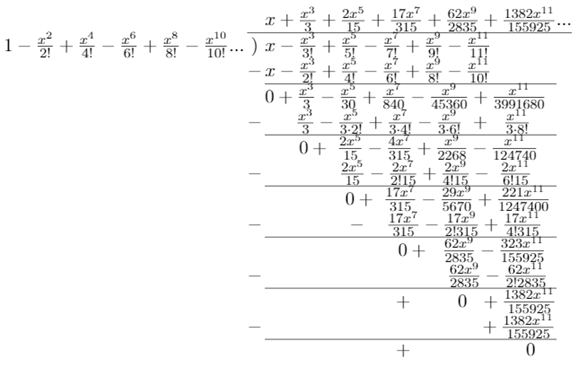Series representation of $e^{-x}$
We know that:
$e^x=1+x+\dfrac{x^2}{2!}+\dfrac{x^3}{3!}+\dfrac{x^4}{4!}+\dfrac{x^5}{5!}+\dfrac{x^6}{6!}+O(x^8)$
$e^{-x}=1+(-x)+\dfrac{(-x)^2}{2!}+\dfrac{(-x)^3}{3!}+\dfrac{(-x)^4}{4!}+\dfrac{(-x)^5}{5!}+\dfrac{(-x)^6}{6!}+O(x^8)$
$=1-x+\dfrac{x^2}{2!}-\dfrac{x^3}{3!}+\dfrac{x^4}{4!}-\dfrac{x^5}{5!}+\dfrac{x^6}{6!}+O(x^8)$
Series representation of $e^{-x^2}$
$e^x=1+x+\dfrac{x^2}{2!}+\dfrac{x^3}{3!}+\dfrac{x^4}{4!}+\dfrac{x^5}{5!}+\dfrac{x^6}{6!}+O(x^8)$
$e^{-x^2}=1+(-x^2)+\dfrac{(-x^2)^2}{2!}+\dfrac{(-x^2)^3}{3!}+\dfrac{(-x^2)^4}{4!}+\dfrac{(-x^2)^5}{5!}+\dfrac{(-x^2)^6}{6!}+O(x^8)$
$=1-x^2+\dfrac{x^4}{2!}-\dfrac{x^6}{3!}+\dfrac{x^8}{4!}-\dfrac{x^{10}}{5!}+\dfrac{x^{12}}{6!}+O(x^{14})$
Series representation of $\dfrac{1}{\sqrt{2\pi}}e^{\frac{-x^2}{2}}$ (Normal distribution function)
$e^{-x^2}=1-x^2+\dfrac{x^4}{2!}-\dfrac{x^6}{3!}+\dfrac{x^8}{4!}-\dfrac{x^{10}}{5!}+\dfrac{x^{12}}{6!}+O(x^{14})$
$\dfrac{1}{\sqrt{2\pi}}e^{\frac{-x^2}{2}}=\dfrac{1}{\sqrt{2\pi}}\left(1-\dfrac{x^2}{2}+\dfrac{x^4}{4\cdot 2!}-\dfrac{x^6}{8\cdot 3!}+\dfrac{x^8}{16\cdot 4!}-\dfrac{x^{10}}{32\cdot 5!}+\dfrac{x^{12}}{64\cdot 6!}+O(x^{14})\right)$
Series representation of $e^{2x}$
$e^x=1+x+\dfrac{x^2}{2!}+\dfrac{x^3}{3!}+\dfrac{x^4}{4!}+\dfrac{x^5}{5!}+\dfrac{x^6}{6!}+O(x^8)$
$e^{2x}=1+2x+\dfrac{(2x)^2}{2!}+\dfrac{(2x)^3}{3!}+\dfrac{(2x)^4}{4!}+\dfrac{(2x)^5}{5!}+\dfrac{(2x)^6}{6!}+O(x^8)$
$=1+2x+\dfrac{4x^2}{2!}+\dfrac{8x^3}{3!}+\dfrac{16x^4}{4!}+\dfrac{32x^5}{5!}+\dfrac{64x^6}{6!}+O(x^8)$
$=1+2x+2x^2+\dfrac{4x^3}{3}+\dfrac{2x^4}{3}+\dfrac{4x^5}{15}+\dfrac{4x^6}{45}+O(x^8)$
Series representation of $\sin(2x)$
$\sin(x)=x-\dfrac{x^3}{3!}+\dfrac{x^5}{5!}-\dfrac{x^7}{7!}+\dfrac{x^9}{9!}-\dfrac{x^{11}}{11!}+\dfrac{x^{13}}{13!}+O(x^{15})$
$\sin(2x)=2x-\dfrac{(2x)^3}{3!}+\dfrac{(2x)^5}{5!}-\dfrac{(2x)^7}{7!}+\dfrac{(2x)^9}{9!}-\dfrac{(2x)^{11}}{11!}+\dfrac{(2x)^{13}}{13!}+O(x^{15})$
$=2x-\dfrac{8x^3}{3!}+\dfrac{32x^5}{5!}-\dfrac{128x^7}{7!}+\dfrac{512x^9}{9!}-\dfrac{2048x^{11}}{11!}+\dfrac{8192x^{13}}{13!}+O(x^{15})$
$=2x-\dfrac{4x^3}{3}+\dfrac{4x^5}{15}-\dfrac{8x^7}{315}+\dfrac{4x^9}{2835}-\dfrac{8x^{11}}{155925}+\dfrac{8x^{13}}{6081075}+O(x^{15})$
$$ \Leftrightarrow \sum_{k=0}^{\infty}\dfrac{(-1)(2x)^{2n+1}}{(2n+1)!}$$
Series representation of $\cos(2x)$
$\cos(x)= 1-\dfrac{x^2}{2!}+\dfrac{x^4}{4!}-\dfrac{x^6}{6!}+\dfrac{x^8}{8!}-\dfrac{x^{10}}{10!}+\dfrac{x^{12}}{12!}...$
$\cos(2x)= 1-\dfrac{(2x)^2}{2!}+\dfrac{(2x)^4}{4!}-\dfrac{(2x)^6}{6!}+\dfrac{(2x)^8}{8!}-\dfrac{(2x)^{10}}{10!}+\dfrac{(2x)^{12}}{12!}...$
$=1-\dfrac{4x^2}{2!}+\dfrac{16x^4}{4!}-\dfrac{64x^6}{6!}+\dfrac{256x^8}{8!}-\dfrac{(1024x)^{10}}{10!}+\dfrac{(4096x)^{12}}{12!}+...$
$=1-2x^2+\dfrac{2x^4}{3}-\dfrac{4x^6}{45}+\dfrac{2x^8}{315}-\dfrac{4x^{10}}{14175}+\dfrac{4x^{12}}{467775}+...$
$$\Leftrightarrow \sum_{k=0}^{\infty}\dfrac{(-1)(2x)^{2n}}{(2n)!}$$
Series representation of $\tan(2x)$
$\tan(x)=x+\dfrac{x^3}{3}+\dfrac{2x^5}{15}+\dfrac{17x^7}{315}+\dfrac{62x^9}{2835}+\dfrac{1382x^{11}}{155925}...$
$\tan(2x)=2x+\dfrac{(2x)^3}{3}+\dfrac{2(2x)^5}{15}+\dfrac{17(2x)^7}{315}+\dfrac{62(2x)^9}{2835}+\dfrac{1382(2x)^{11}}{155925}...$
$=2x+\dfrac{8x^3}{3}+\dfrac{64x^5}{15}+\dfrac{2176x^7}{315}+\dfrac{31744x^9}{2835}+\dfrac{2830336x^{11}}{155925}...$
Series representation of $\cos(2x)$
$\cos(x)= 1-\dfrac{x^2}{2!}+\dfrac{x^4}{4!}-\dfrac{x^6}{6!}+\dfrac{x^8}{8!}-\dfrac{x^{10}}{10!}+\dfrac{x^{12}}{12!}...$
$\cos(2x)= 1-\dfrac{(2x)^2}{2!}+\dfrac{(2x)^4}{4!}-\dfrac{(2x)^6}{6!}+\dfrac{(2x)^8}{8!}-\dfrac{(2x)^{10}}{10!}+\dfrac{(2x)^{12}}{12!}...$
$=1-\dfrac{4x^2}{2!}+\dfrac{16x^4}{4!}-\dfrac{64x^6}{6!}+\dfrac{256x^8}{8!}-\dfrac{(1024x)^{10}}{10!}+\dfrac{(4096x)^{12}}{12!}+...$
$=1-2x^2+\dfrac{2x^4}{3}-\dfrac{4x^6}{45}+\dfrac{2x^8}{315}-\dfrac{4x^{10}}{14175}+\dfrac{4x^{12}}{467775}+...$
$$\Leftrightarrow \sum_{k=0}^{\infty}\dfrac{(-1)(2x)^{2n}}{(2n)!}$$
Series representation of $\tan(2x)$
$\tan(x)=x+\dfrac{x^3}{3}+\dfrac{2x^5}{15}+\dfrac{17x^7}{315}+\dfrac{62x^9}{2835}+\dfrac{1382x^{11}}{155925}...$
$\tan(2x)=2x+\dfrac{(2x)^3}{3}+\dfrac{2(2x)^5}{15}+\dfrac{17(2x)^7}{315}+\dfrac{62(2x)^9}{2835}+\dfrac{1382(2x)^{11}}{155925}...$
$=2x+\dfrac{8x^3}{3}+\dfrac{64x^5}{15}+\dfrac{2176x^7}{315}+\dfrac{31744x^9}{2835}+\dfrac{2830336x^{11}}{155925}...$










